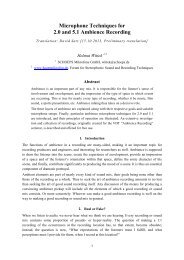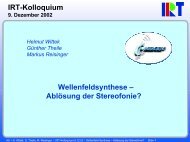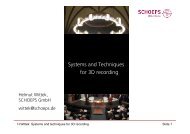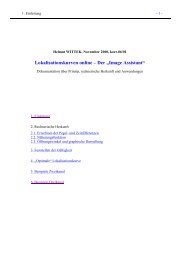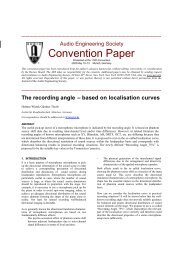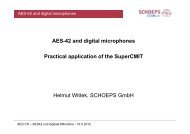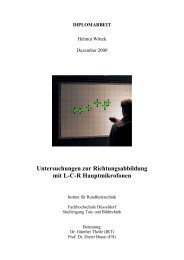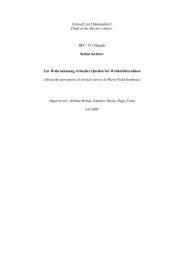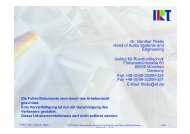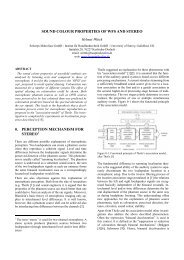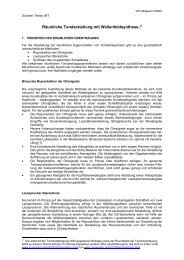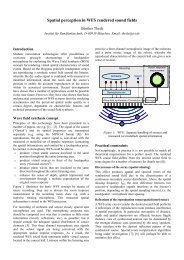on the localisation in the superimposed soundfield - Hauptmikrofon ...
on the localisation in the superimposed soundfield - Hauptmikrofon ...
on the localisation in the superimposed soundfield - Hauptmikrofon ...
Create successful ePaper yourself
Turn your PDF publications into a flip-book with our unique Google optimized e-Paper software.
32<br />
A rigorous perceptual model for auditory percepti<strong>on</strong> is given by a psychologically<br />
oriented localisati<strong>on</strong> model that was proposed by PLENGE 1973. This model probably<br />
offers a comprehensive explanati<strong>on</strong> for <strong>in</strong>side-<strong>the</strong>-head locatedness (Figure 15).<br />
It comprises both short- and l<strong>on</strong>g-term memory as well as a stimulus process<strong>in</strong>g<br />
mechanism that compares stored stimulus patterns to <strong>in</strong>put patterns. The stimulus<br />
process<strong>in</strong>g does not lead to (externalised) localisati<strong>on</strong> if (1) <strong>the</strong> short-term memory<br />
does not c<strong>on</strong>ta<strong>in</strong> or (still) c<strong>on</strong>ta<strong>in</strong>s wr<strong>on</strong>g <strong>in</strong>formati<strong>on</strong> about sound sources and <strong>the</strong>ir<br />
locati<strong>on</strong>s or (2) <strong>the</strong> stimuli are of such a k<strong>in</strong>d that “<strong>the</strong>y cannot be mapped to a<br />
stimulus pattern c<strong>on</strong>ta<strong>in</strong>ed <strong>in</strong> l<strong>on</strong>g-term memory”.<br />
Remarkably, <strong>in</strong> this model localisati<strong>on</strong> is traced back to a learn<strong>in</strong>g process, <strong>the</strong> shortterm<br />
as well as <strong>the</strong> l<strong>on</strong>g-term memory be<strong>in</strong>g of particular importance. The approach<br />
“stimulus process<strong>in</strong>g by means of comparis<strong>on</strong> with stored stimulus patterns” is<br />
c<strong>on</strong>ta<strong>in</strong>ed <strong>in</strong> <strong>the</strong> associati<strong>on</strong> model. The “associatively guided pattern recogniti<strong>on</strong>” can<br />
be seen as its fur<strong>the</strong>r development.<br />
3.2.2 The functi<strong>on</strong><strong>in</strong>g of <strong>the</strong> associati<strong>on</strong> model<br />
The above c<strong>on</strong>siderati<strong>on</strong>s lead to <strong>the</strong> follow<strong>in</strong>g functi<strong>on</strong>al pr<strong>in</strong>ciple of <strong>the</strong> associati<strong>on</strong><br />
model (Figure 16).<br />
Apart from <strong>the</strong> peripheral stage that subdivides <strong>the</strong> ear signals <strong>in</strong>to spectral<br />
comp<strong>on</strong>ents of approximately c<strong>on</strong>stant relative bandwidth with <strong>the</strong> help of filter banks<br />
(see ZWICKER / FELDKELLER 1967, DUIFHUIS 1972, BLAUERT 1974, 1978),<br />
<strong>the</strong> associati<strong>on</strong> model comprises <strong>the</strong> two central process<strong>in</strong>g stages “locati<strong>on</strong><br />
associati<strong>on</strong> stage” and “gestalt associati<strong>on</strong> stage”. Each of <strong>the</strong>se two process<strong>in</strong>g<br />
mechanisms takes place <strong>in</strong> <strong>the</strong> form of an associatively guided pattern selecti<strong>on</strong>.<br />
Hav<strong>in</strong>g passed <strong>the</strong> peripheral stage, certa<strong>in</strong> ear signals give rise to a locati<strong>on</strong><br />
associati<strong>on</strong> <strong>in</strong> <strong>the</strong> first and to a gestalt associati<strong>on</strong> <strong>in</strong> <strong>the</strong> sec<strong>on</strong>d, higher-level stage.<br />
The two stages always determ<strong>in</strong>e <strong>the</strong> auditory event properties <strong>in</strong> a c<strong>on</strong>jo<strong>in</strong>t fashi<strong>on</strong>.<br />
The rigorous differentiati<strong>on</strong> of <strong>the</strong>se two stimulus evaluati<strong>on</strong> stages corresp<strong>on</strong>ds<br />
entirely to <strong>the</strong> two elementary areas of auditory experience. The received ear signals<br />
can be attributed to <strong>the</strong> two sound source characteristics of “locati<strong>on</strong>” and “signal”,<br />
which are <strong>in</strong>dependent of each o<strong>the</strong>r but always occur <strong>in</strong> a pairwise fashi<strong>on</strong>.<br />
In pr<strong>in</strong>ciple, <strong>the</strong> two central evaluati<strong>on</strong> stages <strong>the</strong>refore also c<strong>on</strong>ta<strong>in</strong> <strong>the</strong> same<br />
process<strong>in</strong>g mechanisms. Similar to <strong>the</strong> locati<strong>on</strong> associati<strong>on</strong> stage’s mechanism for<br />
localisati<strong>on</strong> stimulus selecti<strong>on</strong> that was outl<strong>in</strong>ed above, <strong>the</strong> gestalt associati<strong>on</strong> stage<br />
c<strong>on</strong>ta<strong>in</strong>s a mechanism for <strong>the</strong> selecti<strong>on</strong> of <strong>the</strong> gestalt.



